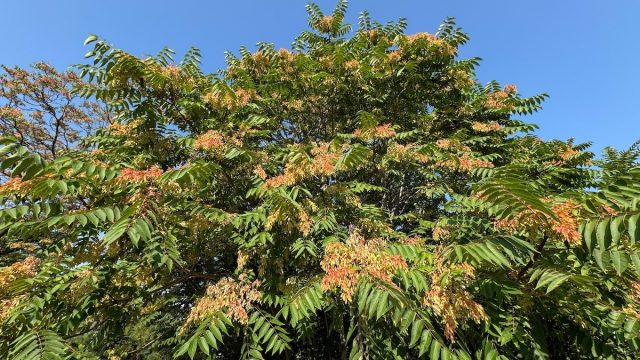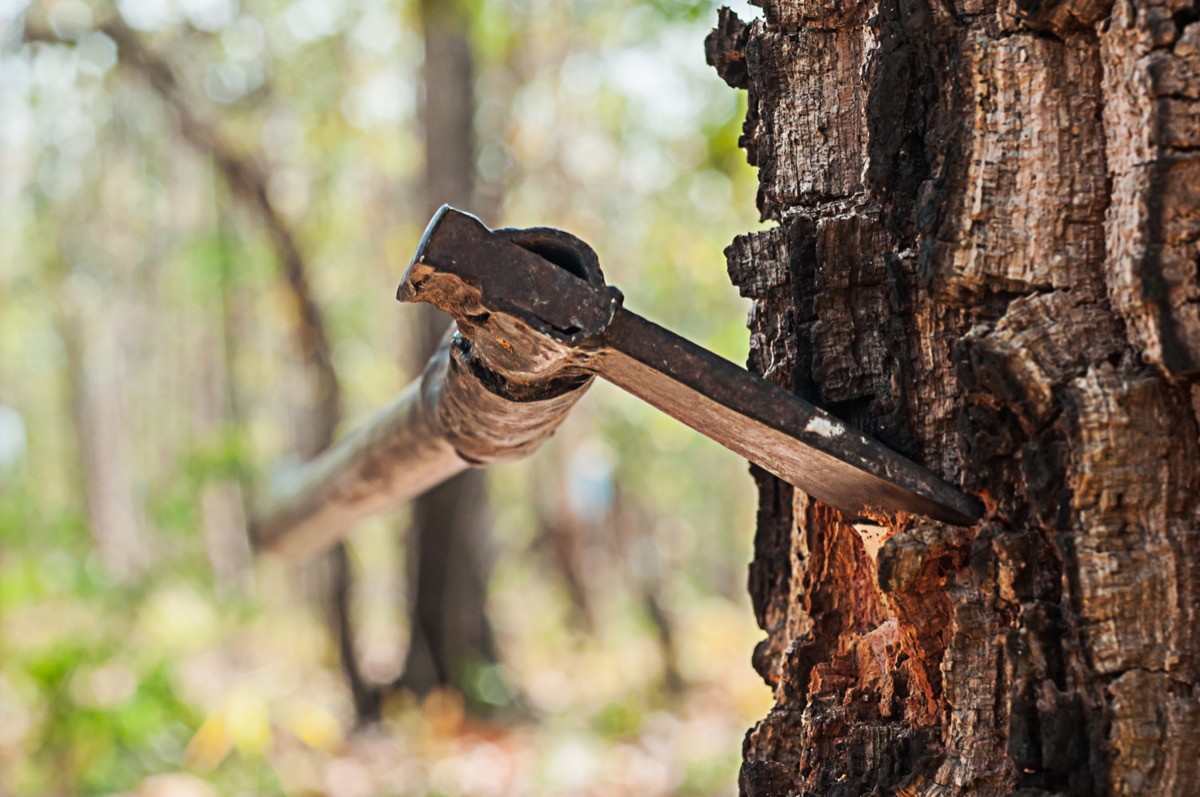Kill This Invasive Tree Before It Kills Your Yard, Experts Warn
It threatens surrounding plants and even the foundation of your home.

You may have had to remove a tree on your property if it got damaged in a storm and became unsafe, or if its roots start encroaching on underground utility lines. But there’s another reason you may need to call in a tree removal service: You’ve unknowingly ended up with an invasive species in your yard. Experts are warning about one particular tree variety that poses a threat to other plants, as well as the foundation of your home. Read on to find out which tree you’ll want to kill and cut down immediately if you spot it.
RELATED: 7 Plants You Can Buy That Are Actually Dangerous Invasive Species.
The tree-of-heaven is anything but.

Tree-of-heaven (also known as Ailanthus) is actually a misnomer, as this plant tends to be more demonic than angelic.
According to the Nature Conservancy, this plant was first brought to the U.S. from China in the late 18th century. Similar to other invasive plants, this tree has no natural predators in the U.S. and can spread quickly. As North America and China have similar climates, tree-of-heaven has been successful at infiltrating 44 U.S. states, according to Charles van Rees, PhD, conservation scientist, naturalist, and founder of the Gulo in Nature blog.
“You may encounter this plant, especially in urban areas, everywhere in the mainland U.S. except Montana, Wyoming, and the Dakotas,” van Rees tells Best Life.
He says you can recognize this tree by its long, stalk-like leaves “with a bunch of little leaf-looking things growing along it.” Also check for hair on the tree’s twigs, which are fuzzy and reddish-brown, as well as “tight clusters of little wind-dispersing seeds.”
“The leaves of tree-of-heaven have sharp, lance-shaped leaflets, and they smell gross if you crush them,” van Rees said, adding that this is a good way to distinguish the tree from native species that it resembles, including the black walnut tree, various ash trees, and some varieties of sumac.
Tree-of-heaven can threaten other plants, as well as the structure of your home.
Tree-of-heaven can threaten other plants, as well as the structure of your home.

In addition to crowding other plants, tree-of-heaven weakens and kills other species by secreting chemicals into the soil, a process that is called allelopathy, van Rees notes.
“The aggressiveness and allelopathy of tree-of-heaven makes them extremely disruptive to existing vegetation, which disrupts habitat structure for other plant and animal species, and disrupts the food web by changing available food plants,” he explains.
The tree also acts as a breeding ground for the spotted lanternfly, a harmful invasive insect. Perhaps even worse, it poses a threat to infrastructure, particularly concrete structures, and root growth can even damage pavement and plumbing.
“This is particularly problematic because it can live just about anywhere, even in poor-quality soils, and in all kinds of shaded or sunny environments,” van Rees says. “Besides its impacts on native ecosystems and species, the Ailanthus has a pretty ugly smell to it, so it’s a bit of a pest.”
RELATED: 5 Signs That Invasive Insects Are Slowly Killing Your Trees.
There are different approaches to killing this tree.

According to van Rees, there are different ways to tackle a tree-of-heaven problem, depending on what stage of life the plant is in.
When it’s young, the tree can be pulled out of the ground, but if you’re dealing with an older tree, the process becomes more complex. This is thanks to a “strong and thick” taproot that the plant grows deep into the soil, which makes pulling difficult and sometimes requires mechanical removal.
“People usually resort to cutting down the plant at this point, but this is unlikely to kill the plant, which can spread through its roots (called suckers in this case) underground,” van Rees says. “To ensure that it is killed, some people will cut all of the above-ground trunks or stalk, then drip some herbicide right onto the cut stem so that it gets into the vascular tissue and then into the root. This can stress and kill the plant.”
Van Rees explains that this is a better approach than just spreading herbicide, which can actually kill plants in the surrounding area. However, he adds that some experts recommend yet another approach.
“Plant pest control experts at Pennsylvania State University Extension recommend treating the roots of well-established plants with specific herbicides, waiting until late summer or early fall to apply them at the right time,” he says. “For homeowners, the simpler ‘hack and squirt’ method may be best, where you cut a notch in the stem of the plant and apply herbicide to the wound so it enters the vascular tissue.”
The Bradford pear tree can also wreak havoc on your property.

Experts have issued warnings about other invasive trees, including the Bradford pear. While its decorative white blooms are a pretty sight to see, these trees can actually “choke out other plants,” according to USA Today.
They also produce a rather unpleasant smell, which has been compared to dead fish and urine, and when they cross with other pear varieties, their offspring (called Callery pears) produce “thorns and thug-like thickets” that are sharp enough to puncture the tire of your car.
Needless to say, if you have a Bradford pear tree in your yard, you should cut it down as soon as possible. In some states, the tree has even been banned.





















